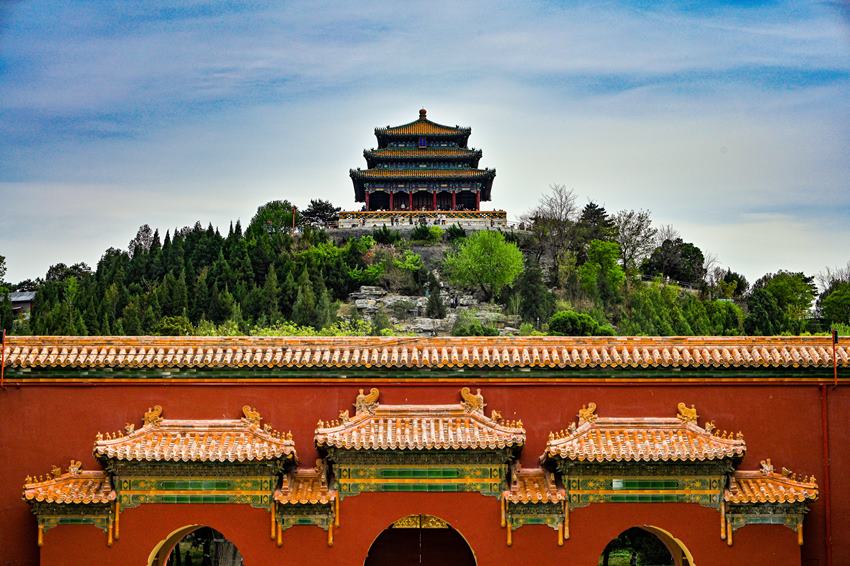
Chinese Name: 景山公园 Pronunciation: jǐng shān gōng yuán
Building Time: 1271
Recommended Time for Visit: 1-2 Hours
Address: No. 44 West Jingshan Street, Xicheng District, Beijing
Occupied Area: 57 acres (about 23,000 square meters)
Building Function: An imperial garden, emperors of the Ming and Qing dynasties (from1271 to 1911)made sacrifices to their ancestors.
|
Visitors
|
Daily Price
|
Price when there are events
|
|
Adult
(Age19-59)
|
2 yuan | 10 yuan |
|
Child
(Age 6-18)
|
1 yuan | 5 yuan |
1. Free of charge for children below 1.2m or under 6 years old.
2. Seniors over 60 years old can exchange the free tickets at the ticket office of Jingshan Park with a passport.
Notice: Ticket fare above contains the main admission only, price for other exhibitions and entertainments are not included.
|
Park Gate
|
Peak Season
(April 1st to October 31st)
|
Low Season
(November 1st to March 31st)
|
| Opening Hours | 6:30-21:00 | 6:30-20:00 |
| Ticket Office Opening Hours | 6:00-20:30 | 6:30-19:30 |
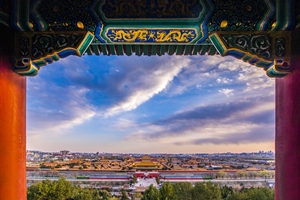
Located on the central point of the north-south axis of Beijing's inner city, face to face with the north gate of the Forbidden City, near The North Sea in the west, and watching the Drum Tower from the distance in the north, Jingshan Park was the imperial garden of the Yuan, Ming and Qing three dynasties. It was opened as a scenery spot in 1928 and was designated as the key cultural relics protection unit in Beijing in 1957.
In 2001, it was listed as the national cultural relics protection site and designated as the National 4A scenic spot. In 2005, it was rated as the "Boutique Park" in Beijing.
Jingshan Park covers an area of 57 acres (about 230,000 square meters). It was built on Jingshan Hill which has been renamed many times, for example, Castle Peak, Long Live Hill(Wansui shan), Zhenshan Hill, Jingshan Hill. Jingshan Hill was also known as Coal Hill in the folk. The summit of the hill is the highest point in Beijing. Looking from the peak, the visitor will get a full view of the Forbidden City.
In Jingshan Park, you can see the towering ancient trees, the unique peaks, the lofty temples, and various kinds of peonies and rich cultural activities. With five pavilions in a row, Wanchun Pavilion is located at the top of the central axis of Beijing. Visitors can enjoy not only a panoramic view of the Forbidden City and the axis of the capital but also the charm of the symmetrical layout and the magnificent palace buildings.
Jingshan Park was once an important place for the Ming and Qing emperors to worship and remember their ancestors. It has preserved the hall of Longevity, the Guande Hall, the Loyalty Temple, Qiwang Pavilion and other historical relics, which can be traced back to our roots and ancestors. And it is a resort for inheriting and carrying forward the culture of Chinese filial piety.
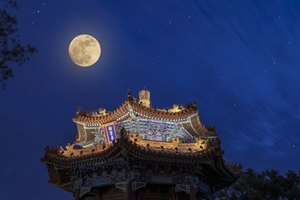
Jingshan Park has a history of nearly 1,000 years. During the Liao Dynasty, Youzhou was named as Nanjing. To build Yaoyu Palace, the Emperor Taizong of Liao, Yelu Deguang, commanded to dig the mud of the north sea and to pile it on the top of two larger mounds, Jingshan and Qionghua Island respectively. Since then, Jingshan Hill came into being.
Emperor Kublai Khan of the Yuan Dynasty designated Jingshan Garden as an important part of the imperial city. At that time, the garden and the hill were called “Houyuan”(Secret Garden) and "Green Hill". Jixiang Pavilion and Xingqing Pavilion were built. Pines and cypresses were planted, and green pavilions(pavilions with vegetation cover) were built on the hill.
In the Ming Dynasty, emperors built the Fengxian Temple, the Guande Hall and the Loyalty Temple behind the mountain to offer sacrifices to ancestors. Peonies and other precious plants were planted there. At that time, the hill was called “Long Live Hill”(Wansui Hill).
In 1644, when Li Zicheng(a peasant uprising leader) broke in Beijing, Emperor Chongzhen(the last emperor of the Ming Dynasty) hanged himself in Long Live Hill(Wansui Hill). In the 8th year of the Shunzhi Emperor of the Qing Dynasty, Wansui Hill was renamed as Jingshan Hill. During the reign of another emperor Qianlong, Qiwang Pavilion was built in front of the hill. The architecture of Jingshan Hill reached its most brilliant and prosperous stage then.
In 1928, it was opened as a park.
In 1957, Jingshan Park was listed as the cultural relics protection unit of Beijing.
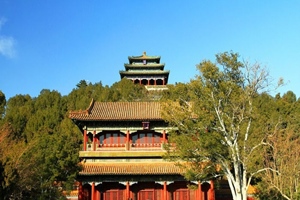
Built-in 1750, the 15th year of emperor Qianlong's reign in the Qing Dynasty, this building was a place for students of Jingshan Official School to worship Confucius. It lies inside the Jingshan gate and covers 201.92 square meters. The name of this pavilion means that this is a place to climb up and enjoy the beautiful scenery. At the foot of the hill, Qiwang Pavilion stands facing south, with yellow glazed tile peak, heavy double eaves, and surrounded by white marble guardrail. It enshrines the memorial tablet of Confucius. During the Republic of China period, exhibitions were once held in this pavilion. For example, on February 25, 1937, here, the Palace Museum exhibited more than 600 photos of Chinese ancient cultural relics.
Built-in 1750, the 15th year of emperor Qianlong's reign in the Qing Dynasty.
The Zhoushang Pavilion
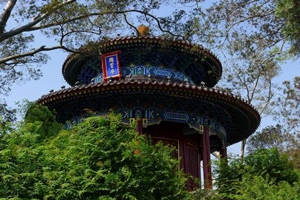
It is opposite to the Fulan Pavilion in the west. The architectural form and painting of the two pavilions are the same. The pavilion is 11.75 meters high and covers an area of 76.36 square meters. The pavilion has double eaves, round and peaked roof, covered with peacock blue glazed tiles and the edges cut were covered with purple crystal glazed tiles.
There was the Treasure Buddha (one of the Five Dhyani Buddhas) statue in the Zhoushang Pavilion, with a gold-plating copper body, which was robbed in 1900 (the 26th year of the reign of Emperor Guangxu) by the Eight-power Allied Forces.
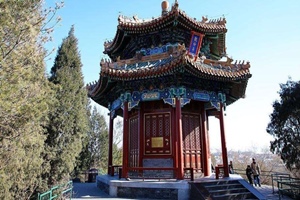
Opposite to the JiFang Pavilion on the west side, the two pavilions have the same architectural form and paint color. The pavilion is 12.05 meters high and covers an area of 90.30 square meters, with a double-eave round and peaked roof. The peaked roof covered with emerald-green glazed tile, and the edge cut covered with yellow glazed tile.
There was a Buddha statue in the Pavilion, with a gold-plating copper body. But it was robbed in 1900 (the 26th year of the reign of Emperor Guangxu) by the Eight-power Allied Forces.
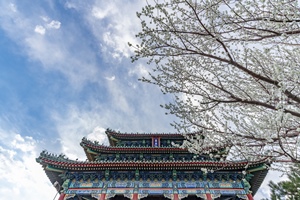
The Wanchun Pavilion
Located at the highest point of Jingshan Hill, it was known as the commanding point on the central axis of Beijing. The pavilion is 15.38 meters high, with an area of 296.5 square meters. Its painting was also the highest form of Chinese royal painting.
The original Buddha statue in the pavilion was destroyed in the 1960s, but rebuilt and restored, and reopened to the public in 2000.
The Jifang Pavilion
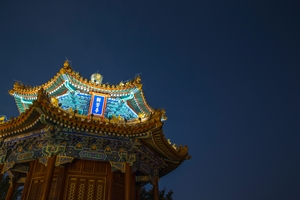
Opposite to the Guanmiao Pavilion on the east side, the two pavilions have the same architectural form and paint color. The pavilion is 12.05 meters high and covers an area of 90.30 square meters, with the double-eave round and peaked roof, emerald-green glazed tile-covered roof, and yellow glazed tile edge cut.
There was an Amituofo Buddha statue in the Pavilion, with a gold-plating copper body, which was robbed in 1900 (the 26th year of the reign of Emperor Guangxu) by the Eight-power Allied Forces.
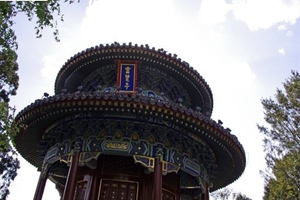
Opposite to the Zhoushang Pavilion on the east side, the two pavilions have the same architectural form and paint color. The pavilion is 11.75 meters high and covers an area of 76.36 square meters.
There was an Amoghasiddhi Buddha statue in the Pavilion, with a gold-plating copper body. It was robbed in 1900 (the 26th year of The Reign of Emperor Guangxu) by the Eight-power Allied Forces.
The Peony Garden
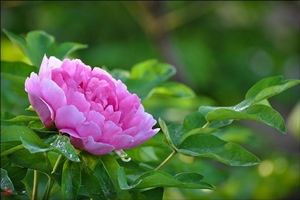
Located in the south gate of the Guande Hall, the Peony Garden is the largest peony garden in Beijing, forming a unique flower seasonal landscape. In May every year, 20000 of 200 species of peonies in the garden are in full bloom, which is a magnificent sight. The peonies in Jingshan Park are famous for their large flowers, brilliant colors, tall plants and long age. There are not only famous peonies of the royal garden but also famous peonies from Luoyang and Heze. Among them, Yao Huang, Wei Zi, Black peony, Green peony, and white peony, all of which make the Jingshan Park gorgeous.
Every summer, in the Qingyun Scenic Area of Nanmen Square, red vines are swaying and lotus scent is permeated. They are in harmony with the colorful bunches of red, phlox, Verbena hybrida, impatiens, green leaves, and lilies by the pond. All of these make the place full of the ancient charm of serenity and peace.
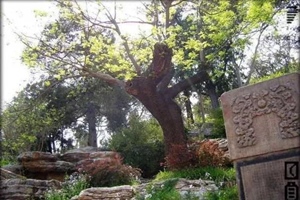
Another cultural landscape of the park is the site of Emperor Chongzhen's Suicide. At the eastern foot of Jingshan Hill, there was a low old locust tree leaning to the east. This was the place where the emperor Chongzhen( Zhu Youjian, of the Ming Dynasty) hanged himself. At the end of the Ming Dynasty, Li Zicheng(a peasant uprising leader)'s rebels broke into Beijing in March 1644. On March 19, the emperor Chongzhen fled to Jingshan Hill. Feeling ashamed in front of his ancestors, he committed to suicide with his belt over a lopsided-neck pagoda tree under the Guanmiao Pavilion.
During the ten years of unrest(the Revolution of Culture 1967-1977), the old locust tree was cut down as the "four olds (old ideas, old culture, old customs and old habits)", and an old locust tree was replaced on the site in 1981. In 1996, the Park Management office transplanted a locust tree(over 150 years old) in front of No. 7, Beishuncheng Street, Jianguomen, Dongcheng District to the original location of the low old locust tree, replacing the small ones which were newly transplanted in 1981.
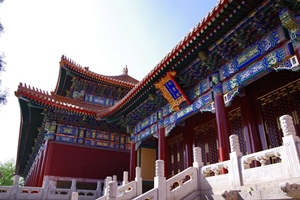
In the Ming Dynasty, the Shouhuang Palace group used to be located in the northeast corner of Jingshan Garden. In the 14th year of the emperor Qianlong in the Qing Dynasty (1749), it was rebuilt to the north of Jingshan Hill. Then Shouhuang Palaces became the only important building group added on the central axis since the planning of the City had been formed in the Qing Dynasty. The Hall of Shouhuang Palace was used to consecrate portraits and memorial tablets from the emperor Kangxi to emperor Guangxu. On New Year's Day, the New Year's Eve, the Lunar New Year's Day, the Emperor's birthday and the anniversary of the death, the royal family would hold the grand ceremony here.
Route 1: South Gate - Site of Emperor Chongzhen's Suicide - uphill from back mountain road - Zhoushang Pavilion - Guanmiao Pavilion - Wanchun Pavilion - Jifang Pavilion - Fulan Pavilion - the Shouhuang Palace(an appointment in advance is needed) - East Gate
Route 2: West Gate - up the hill from the main road - Site of Emperor Chongzhen's Suicide - back mountain road - Zhoushang Pavilion - Guanmiao Pavilion - Wanchun Pavilion - Jifang Pavilion - Fulan Pavilion - West Gate
Route 3: East Gate - the Shouhuang Palace(an appointment in advance is needed) - up the Hill from the road to Zhoushang Pavilion - Guanmiao Pavilion - Wanchun Pavilion - Jifang Pavilion - Fulan Pavilion - downhill to the Popular Science Propaganda Column - the main road of the front hill - site of Emperor Chongzhen's Suicide - East Gate
Take bus 101, 103, 109, 124, 128 or Xidan Tourist Line 1, 2, 3 and get off at Gugong (the Forbidden City) Station, near the South Gate.
Take bus 58, 111, 124 or Tourist Line 3 and get off at Jingshan East Gate Station.
Take bus 5, 58 and get off at Xibanqiao Station, near the West Gate
By Subway
Take Line 8 and get off at National Art Museum Station, get out from Exit A. Walk about 1.1km to the west to reach South Gate;
Take Line 6 and get off at Nanluoguxiang Station, get out from Exit A. Walk about 1.3km to the south to North Gate.
By Taxi
Chinese: 请带我去景山公园。English: Please take me to Jingshan Park.
Chinese: 请带我去景山公园的东门。English: Please take me to the East Gate of Jingshan Park.
Chinese: 请带我去景山公园的南门。English: Please take me to the South Gate of Jingshan Park.
If you go to Jingshan Park from the center of Beijing city center(Tiananmen Square), it takes about 15 minutes(20 yuan).
If you go to Jingshan Park from the Beijing Capital International airport, it takes about 50 minutes(90 yuan).
If you go to Jingshan Park from the Beijing Daxing International airport, it takes about 80 minutes(185 yuan).
If you go to Jingshan Park from the Beijing West Train Station, it takes about 35 minutes(40 yuan).
